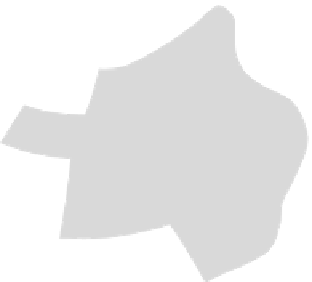Geoscience Reference
In-Depth Information
Pole
Figure 2.9.
On a spherical Earth the motion of plate A relative to plate B must
be a rotation about some pole. All the transform faults on the boundary between
plates A and B must be small circles about that pole. Transform faults can be used to
locate the pole: it lies at the intersection of the great circles which are perpendicular
to the transform faults. Although ridges are generally perpendicular to the
direction of spreading, this is not a geometric requirement, so it is not possible to
determine the relative motion or locate the pole from the ridge itself. (After Morgan
(1968).)
from a few years to a few million years, depending on the method used. These
methods include the following.
1. A local determination of the direction of relative motion between two plates can be
made from the strike of active transform faults. Methods of recognizing transform faults
are discussed fully in Section 8.5. Since transform faults on ridges are much easier to
recognize and more common than transform faults along destructive boundaries, this
method is used primarily to find rotation poles for plates on either side of a mid-
ocean ridge. The relative motion at transform faults is parallel to the fault and is of
constant value along the fault. This means that the faults are arcs of small circles
about the rotation pole. The rotation pole must therefore lie somewhere on the great
circle which is perpendicular to that small circle. So, if two or more transform faults
can be used, the intersection of the great circles is the position of the rotation pole
(Fig. 2.9).
2. The spreading rate along a constructive plate boundary changes as the sine of the angular
distance
θ
from the rotation pole (Eq. (2.3)). So, if the spreading rate at various locations
along the ridge can be determined (from spacing of oceanic magnetic anomalies as
discussed in Chapter 3), the rotation pole and angular velocity can then be estimated.
3. The analysis of data from an earthquake can give the direction of motion and the
plane of the fault on which the earthquake occurred. This is known as a
fault-plane

















